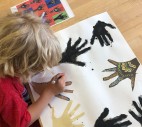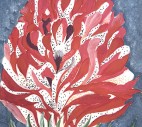Art at The San Francisco School is valued as one of the languages of children.
Art is both serious and joyful. We care about process as much as the finished product. The walls of the halls and classrooms are full of student work. What might you see? Cloth birds hanging from branches, self-portraits revealing sensitive and personal stories of 7th Graders, and Preschool autumn reflection paintings alongside 6th Grade painted abstractions.
The revolving school gallery reveals a commitment to cultivating craft and concept from Preschool through Middle School. In Preschool students create pinch pots, in 3rd Grade they sculpt bird bells, and in 8th Grade they hand-build sophisticated art nouveau pottery. Skills are put to the test - ceramic pots have to hold water; stitching on a stuffed toy needs to hold the stuffing inside; wood sculptures must balance and hold together. Problem solving is real-life and the results are concrete.
For more details about our Visual Arts program, please see the Curriculum Guide.




